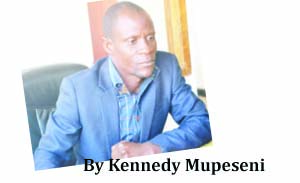THERE is no doubt that sustainable mining is the way to go in achieving the country’s copper production targets.
The Government has set an ambitious target of attaining three million tonnes of copper per year by 2031 which will require a revolutionary approach that will include adopting sustainable mining.
Any economic activity that suffocates the environment should be discouraged and it is encouraging that the Government is putting in place measures to protect the environment alongside promoting investments.
The Government is also reaching out to international partners to promote investments that are tilted towards promotion of sustainable mining.
This was evidenced by the recently held Sweden- Zambia Mining Forum on Sustainable Mining in Kitwe where various stakeholders deliberated on how to adopt modern technology that promoted sustainable mining.
During the forum, Swedish Ambassador to
rich history of mining sustainably.
Meanwhile, Copperbelt Minister, Elisha Matambo said Zambia was believed to be one of the most risk-free mining investment destinations in the world because of the peace it had been enjoying since independence.
Mr Matambo assured that the extensive geological mapping and exploration the government would embark on in the 2024 fiscal year would boost the country’s mining prospects.
He reminded stakeholders and the investor community that as the government emphasised production ramp up, it ensured the promotion of environmental and social governance through sound environmental management.
The investor and community should take advantage of the prevailing conducive mining policy environment to consider increasing investments in the Zambian mining sector.
On the other hand Mine Safety Department (MSD) Chief Inspector Machinery Brighton Kateka said the process of fine tuning the mines and environmental regulations had reached an advanced stage.
“We are in the process of revising the mines and minerals regulations and so far, stakeholders’ consultations have been done, waiting for fine tuning and enactment,” Mr Kateka told delegates.
He said various mining houses including some traditional leaders were consulted to ensure that all stakeholders were involved in the process.
Doing so would help in addressing mining environmental issues being faced in the country as the new regulation would help strengthen the institutional capacity of MSD.
The Government is also looking at developing or strengthening the Environmental Protection Fund (EPF) through the development of new rules about the EPF.
In this vein, Mr Kateka revealed that the ministry is ensuring that all stakeholders are involved in the process.
It should be observed that when the mines changed hands during privatization, most of them, if not all, did not want to inherit environmental liabilities.
“So, the government started shouldering those liabilities and we ended up having to go and borrow money, we ended up going and getting help from the World Bank,” he said.
Mr Kateka said officers had to go around in effort to sanitize various mines in preparation for the incoming environmental protection regulations.
“We are happy that with the help of the Minister and the Permanent
Secretary, we have increased the number of officers who are directly looking at the environmental aspect of mining and going up to having chief inspector of environmental protection to help in environmental governance and sustainability,” he said.
Mr Kateka is also confident that the introduction of a mineral and mining commission will also help in reaching out to various mines as the agency would have the mandate to look after the welfare of staff.
He was reacting to earlier remarks by Care for Nature Zambia Executive Director, Nsama Kearns who called for authorities to strengthen environmental regulations laws in the country.
Mr Kearns was concerned that the miners of manganese and other minerals in Luapula, among others, were polluting the environment at will.
She wanted enforcement of the law on flouting of environmental regulations enhanced to deter polluters from acting with impunity.
Ms Kearns named Luapula Province as an example of an area where some mining investors had no regard for environmental welfare.
She asserted that miners in that jurisdiction were polluting water bodies and threatening biodiversity.
Ms Kearns said if nothing is urgently done to address the problem, the impact of pollution in Luapula would be so severe that it would be hard to make amends.
Indeed ,as much as the country was creating jobs and investments in mining, there was a great need to pay attention to how the environment was being treated.
She noted that apart from the visible poverty in areas where high-grade manganese and sugilite was being mined, there was also a risk of loss of the environment through land grabbing, water pollution and threats on forests.
Hence, regulators should step up efforts aimed at enforcing environmental laws to ensure that the mining of critical minerals such as manganese, did not negatively affect community members.
Investors should view community members as a resource that can be relied upon and not like an obstacle that should be chased to facilitate mining,” she stated.







